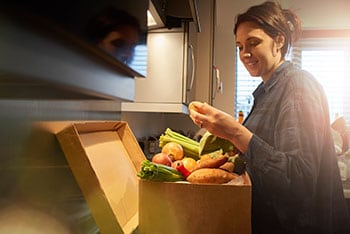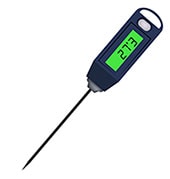Tips for Meal Kit and Food Delivery Safety

Coronavirus Disease 2019 (COVID-19)
There is currently no evidence to support transmission of COVID-19 associated with food. Get answers to other questions about COVID-19 and food from CDC, the Food and Drug Administration, and the U.S. Department of Agriculture.
There is currently no evidence to support transmission of COVID-19 associated with food. Get answers to other questions about COVID-19 and food from CDC, the Food and Drug Administration, and the U.S. Department of Agriculture.
Home-delivered groceries, subscription meal kits, and mail-order food can be convenient. Make sure food safety is part of the package, too. Home-delivered food must be handled properly to prevent food poisoning.
Whether food is shipped to your home or delivered by a local service, it needs to stay at a safe temperature to prevent the growth of germs that could make you sick. Follow these tips to keep you and your family safe while enjoying meals prepared at home from these foods.
Before Ordering
Ask questions first. Research companies and call customer service to ask about food safety standards. This is particularly important if you are buying the food for someone who is more likely to get food poisoning:
- adults age 65 and older,
- children younger than age 5,
- people who have health problems or take medicines that lower the body’s ability to fight germs and sickness (weakened immune system), and
- pregnant women.
Ask how the company responds if food is delivered at an unsafe temperature or is otherwise not safe to eat. Find out if the company provides information with each shipment on safe handling and preparation of food, including cooking temperatures.

Arrange for delivery when someone is at home so food can be refrigerated quickly instead of being left outside until someone is at home. If you can’t be there in person, see if a neighbor can.
Find a safe space for delivery if no one will be at home when food arrives. Food should be delivered to a cool, shaded, and secure location where pests and rodents won’t be able to get it. Let the company know where you would like them to leave your box.
Safe Food Delivery and Receipt
Examine the box and packaging. When you get your delivery, look for stickers on the box that say “Keep Refrigerated” or “Keep Frozen” if you ordered perishable food such as meat, seafood, poultry, eggs, or dairy.
Check the temperature with a food thermometer.

Perishable food should arrive frozen, partially frozen with ice crystals still visible, or at least as cold as it would be in a refrigerator (40°F or below). The only way to know the food is safe to eat is to use a food thermometer to make sure the food is 40°F or below. Even if a perishable food product is smoked, cured, vacuum-packed, or fully cooked, it still must be kept cold.
Make sure the company uses insulated packaging and materials such as dry ice or frozen gel packs to keep perishable food cold in transit.
Refrigerate or freeze your delivery as soon as possible. Bacteria can multiply rapidly if food is kept in the “danger zone” between 40°F and 140°F for more than two hours. After you have made sure that the food was delivered at a safe temperature, store it in the refrigerator or freezer as soon as possible until you are ready to prepare it.
Notify the company if food arrives above 40°F. Don’t eat any of the food, or even taste it to see if it is safe. Food can be unsafe and still taste, look, and smell OK. When in doubt, throw it out.
Call toll-free federal food safety hotlines if you suspect that a food is contaminated or has made someone sick. For meat, poultry, or pasteurized egg products, call the USDA Meat & Poultry Hotline at 1-888-MPHotline (1-888-674-6854). For all other food products, call FDA’s Food and Cosmetic Information Center at 1-888-SAFEFOOD (1-888-723-3366).
Safe Food Handling
Wash your hands and kitchen utensils. Wash your hands with soap and water for at least 20 seconds before, during, and after handling any food and before eating. Wash your utensils, cutting boards, and countertops with hot, soapy water after using them.
Separate foods to avoid cross-contamination. Keep raw meat, poultry, seafood, and eggs away from other foods, and use separate cutting boards, plates, and utensils for these ingredients.
Refrigerate leftovers within 2 hours. Make sure you know how long your leftovers will keep in the fridge or freezer.
No hay comentarios:
Publicar un comentario